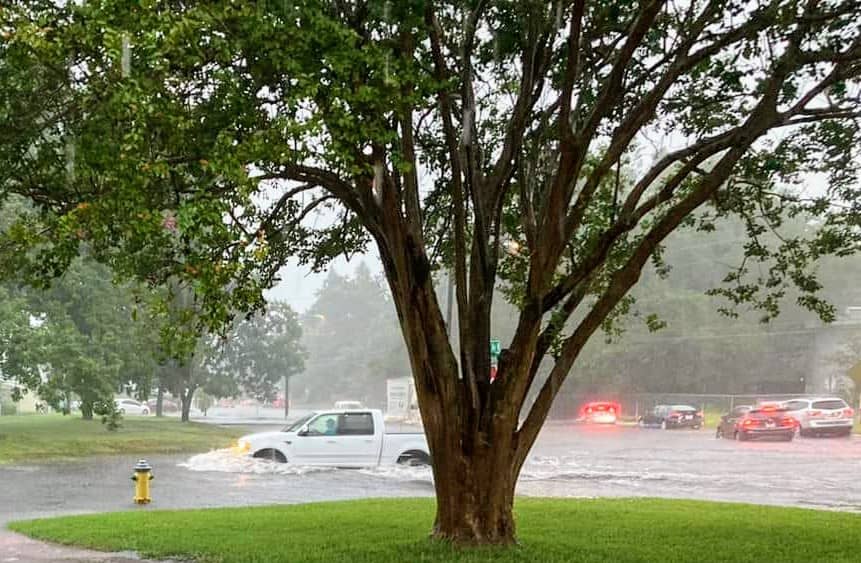Thrive
St. Pete officials continue searching for resiliency solutions

The St. Petersburg City Council received what one administrator called a firehose of information regarding environmental resiliency efforts and increasing flooding issues today.
The over four-hour Committee of the Whole meeting also featured a brief presentation on the much-anticipated Resilient St. Pete action plan. Councilmember Brandi Gabbard requested the extensive updates after recent discussions with Congressional leaders, and torrential rains inundated much of the city in early September.
“Representing a coastal district, I personally know the pain, frustration and hopelessness that our residents have felt and been burdened by over the last few years,” Gabbard said. “It’s my desire that at the end of this meeting … we leave our residents with a message of hope.”
Dr. Gary Mitchum, associate dean of the College of Marine Science at the University of South Florida, kicked off the marathon meeting. He explained that less-dense warmer water causes sea level rise by occupying more space and melting polar ice caps.
Mitchum expects flooding events to increase tenfold in the mid-2030s to nearly 70 days annually. “This is not water into houses, but it’s water that’s making streets impassable,” he said. “It’s a serious infrastructure problem that has a lot of cost associated with it.”
Scientists predict that the number of named storms will decrease amid a warming climate. However, Mitchum said they expect catastrophic Category 4 and 5 hurricanes to increase by 30% to 40%.
City studies show that 668 homes flooded with Hurricane Eta’s 3.47-foot storm surge, and 3.85 feet during Hurricane Idalia inundated 1,535. The city spent $2.075 million on the latter storm, which passed hundreds of miles away from St. Petersburg.
Mitchum said previous municipal leaders built St. Petersburg’s stormwater pipes according to centuries-old rainfall totals. “These more intense storms are simply going to back up into the streets, which is what we’re seeing.”

Recent flooding in the Vinoy Resort & Golf Club’s parking garage. Screengrab, city documents.
Multiple council members would like a real-time reporting platform that notifies residents of flooded roads. Amber Boulding, emergency manager for the city, said the “ebbs and flows” of flooding present a challenge.
She also noted that city officials have identified that as an area for improvement. Mayor Ken Welch offered a potential technological solution.
Officials in Vancouver created a digital twin of the city that shows residents where to expect flooding and what roads remain passable. “That’s down the line, but we’re on the same page of trying to get that real-time information out when it’s not a named storm,” Welch said.
The city has replaced 39 of 65 “identified for replacement” tidal backflow preventers since late February. However, as was often highlighted throughout the meeting, there are no easy answers for complex problems.
Claude Tankersley, public works administrator, explained that rainfall accumulates behind closed backflow preventers. While the valves prevent saltwater intrusion, “you’re going to have some fresh water standing in the street, possibly your yard, waiting for the tide to go down before that fresh water can exit,” he said.
The city has inspected 1,373 stormwater drains since a community outreach event in February. Four recently added crews have aided those efforts.
Tankersley said the city has between 15,000 and 18,000 catch basins and prioritizes problematic systems. City officials will soon proactively identify clogged drains through closed-circuit cameras.

A debris-filled stormwater drain in west St. Pete after torrential rains inundated the neighborhood.
Funding remains a significant hurdle, and relatively minor storms cost the city millions. City documents show that Hurricane Ian, with a negative 4.65-foot storm surge and no reported flooding, cost the city $5.14 million.
Councilmember Lissette Hanewicz noted that city officials allocated $22 million to stormwater-related projects in the upcoming budget. Those will cost roughly $1 billion through 2050.
Tankersley explained that city employees and outside contractors lack the capacity to quickly complete those projects if the funding, including state and federal sources, was available.
Hanewicz stressed that the city is dedicating less than half of the annual cost to complete stormwater projects. At a committee meeting in late July, Tankersley said officials “should be spending $50 million a year” to complete $1 billion in stormwater projects over the next 20 years.
Those costs do not reflect projects identified in an upcoming seawall vulnerability study. “We’re going to have to raise utility rates,” Hanewicz said. “If you don’t have money coming in, how do you pay for this?”
The meeting concluded with a brief update on the Resilient St. Pete action plan. The Tampa Bay Regional Planning Council (TBRPC) will focus on low-lying neighborhoods identified by city officials through the initiative’s first phase.
Cara Serra, director of resiliency for TBRPC, said the organization is identifying gaps and areas for improvement in previous city plans. Community engagement is a critical component.
Serra said the TBRPC would rank resilience projects that align with city and neighborhood goals. Gabbard pledged that the initiative would grow over time.
“I want to be innovative,” Welch said. “I want to work hand in hand with the council to be much more aggressive in getting our improvements planned and in place sooner rather than later – because those impacts are happening right now.”
Despite a nearly 4.5-hour meeting, the council deferred some presentations to Oct. 24.








Page Obenshain
September 23, 2024at9:58 am
Claude Tankersley and others say that development does not contribute to the storm water issue. The city also gives more and more approval for development while some communities seem to be in favor of slowing down or halting further growth. A good example of development hurting our storm water issues is 4th Street and Central. For a few years there was a vacant full city block. It rained and that grasslot absorbed the rainwater and with the new building,the water runs into the street.
Karina Koale
September 21, 2024at4:24 pm
At a committee meeting in late July, Tankersley said officials “should be spending $50 million a year” to complete $1 billion in stormwater projects over the next 20 years.
That 50 million a year goes to the Sunrunner buses project that only a minute portion of St. Petersburg residents use instead of stormwater drainage issues. Sorry but city council members and the Mayor decided that takes priority over your flooded cars and homes.
Will Michaels
September 21, 2024at11:58 am
Thanks to the council for this thoughtful in-depth review of city flood control actions, plans, and budgeting to date. Mayor Welch’s comments about being aggressive in getting improvements planned and in place sooner is appreciated. Formation of the proposed neighborhood advisory task force with the help of the Tampa Bay Regional Planning Council to review and prioritize city flood initiatives and plans is also a positive development.
SB
September 21, 2024at10:10 am
The issue isn’t “resiliency.” The real problem is a neglected stormwater system that’s been underfunded and overlooked for far too long. Why complicate the conversation with trendy buzzwords when it’s clear what we’re dealing with? This is about a stormwater system that everyone knows is outdated, improperly maintained, undersized, and has consistently failed—not only when one area gets five inches of rain in an hour … A predictable event that’s just going to happen.
Of course we would’ve had less or no flooding in certain areas if our stormwater system had been taken care of better.
If we want to keep housing affordable, we need to address this. Otherwise, flood insurance rates will skyrocket, auto insurance premiums will rise, and people will face hefty deductibles and uninsured losses. Businesses, homeowners, and renters will all bear the cost. Let’s call it what it is: fixing a broken stormwater system. No need for euphemisms when the solution is straightforward.
And stop confusing people with rising sea levels, and this summer storm the other day. One has nothing to do with the other. All I read here is constant conflation about these two issues.
Terry Thomas
September 21, 2024at9:23 am
That’s down the line, but we’re on the same page of trying to get that real-time information out when it’s not a named storm,” Welch said.
Play ball with Raymond 🕳️🙄
Lyn Wilkinson
September 21, 2024at6:56 am
The socialism for billionaires project, otherwise known as the Rays/Hines stadium deal, was clearly more important to our current admin and council than the health and safety of the St. Pete taxpayers. Good for Lisette for stating the truth – sewer taxes will need to raised (and it won’t be nearly enough) while we BORROW the money required to build the infrastructure required for the billionaire boondoggle. Sad!
HAL FREEDMAN
September 20, 2024at10:20 pm
And the money and borrowing power tied up in the disastrous Rays/Hines deal, are resources that could have helped find a solution to these issues…oh, but a baseball stadium is apparently more important than flooded neighborhoods. This City has some seriously misplaced priorities.
S. Rose Smith-Hayes
September 20, 2024at8:33 pm
The last storm in August 2024 was regular rain. Our infrastructure has been ignored. You all keep approving new multilevel buildings, inviting new residents and do absolutely nothing about our drainage system. No excuses.